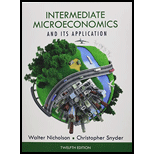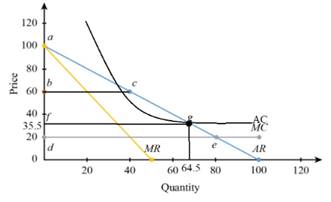
a)
The industry outcome under unregulated
a)
Answer to Problem 11.10P
The
Explanation of Solution
The natural gas is a natural monopoly and the demand curve is given in the question as
According to the given condition,
The price per unit is $60 and the quantity is 40.
Substitute the values in
Total revenue earned is$2,400 and the total cost incurred is $1,800.
Profit earned can be calculated as
The graph of the given unregulated monopoly can be drawn as:

Consumer surplus can be given by the area below the demand curve and above the price line,i.e. the triangle abc.
Total surplus is termed as the social welfare. Thus the value of social surplus in the given condition is $1,400 ($600+$800).
Introduction: Monopoly is a market structure with a single firm selling a unique good. Monopoly is a price maker and has extensive market control. By analyzing the marginal revenue and marginal cost of producing an extra unit, a monopolist can determine its profit maximizing price and quantity.
b)
The regulatory price that maximizes social welfare and the industry outcome under this price is to be calculated.
b)
Answer to Problem 11.10P
The price maximizes social welfare is $20 and the quantity sold will be 80 units. The profit earned will be -$1,000.
Explanation of Solution
The price for maximization of social welfare can be calculated as follows:
By substitution,
Profit is calculated by
This indicates that the regulated monopoly has a negative
Consumer surplus can be given by the area below the demand curve and above the price line, i.e. the triangle ade.
The value of social surplus under regulated monopoly is $2,200 ($3,200-$1,000). The policy of regulation is not sustainable even though it maximizes the social welfare, but it makes the firm losses.
Introduction: Monopoly is a market structure with a single firm selling a unique good. Monopoly is a price maker and has extensive market control. By analyzing the marginal revenue and marginal cost of producing an extra unit, a monopolist can determine its profit maximizing price and quantity.
c)
The industry outcome with the laxer regulatory policy of constraining price and the sustainability of the policy in a long run is to be determined.
c)
Answer to Problem 11.10P
The optimal quantity produced in the given case is 64.5 units.
Explanation of Solution
According to the given condition, price and average cost of production will be charged equal.
The optimal quantity produced will be 64.5 units.
By substitution, we get the price per unit.
The profit in the given case should be zero as the price and the average production cost is charged equally.
Consumer surplus can be given by the area below the demand curve and above the price line, i.e. the triangle afg.
Therefore the consumer surplus is $2,079.80. The value of social welfare in this case is $2,079.80. The policy will be sustainable in long run as the firm is breaking even. This means that their profit is zero and has no incentive to exit.
Introduction: Monopoly is a market structure with a single firm selling a unique good. Monopoly is a price maker and has extensive market control. By analyzing the marginal revenue and marginal cost of producing an extra unit, a monopolist can determine its profit maximizing price and quantity.
Want to see more full solutions like this?
Chapter 11 Solutions
Intermediate Microeconomics and Its Application, 12th edition with CD-ROM



 Microeconomics: Principles & PolicyEconomicsISBN:9781337794992Author:William J. Baumol, Alan S. Blinder, John L. SolowPublisher:Cengage Learning
Microeconomics: Principles & PolicyEconomicsISBN:9781337794992Author:William J. Baumol, Alan S. Blinder, John L. SolowPublisher:Cengage Learning





